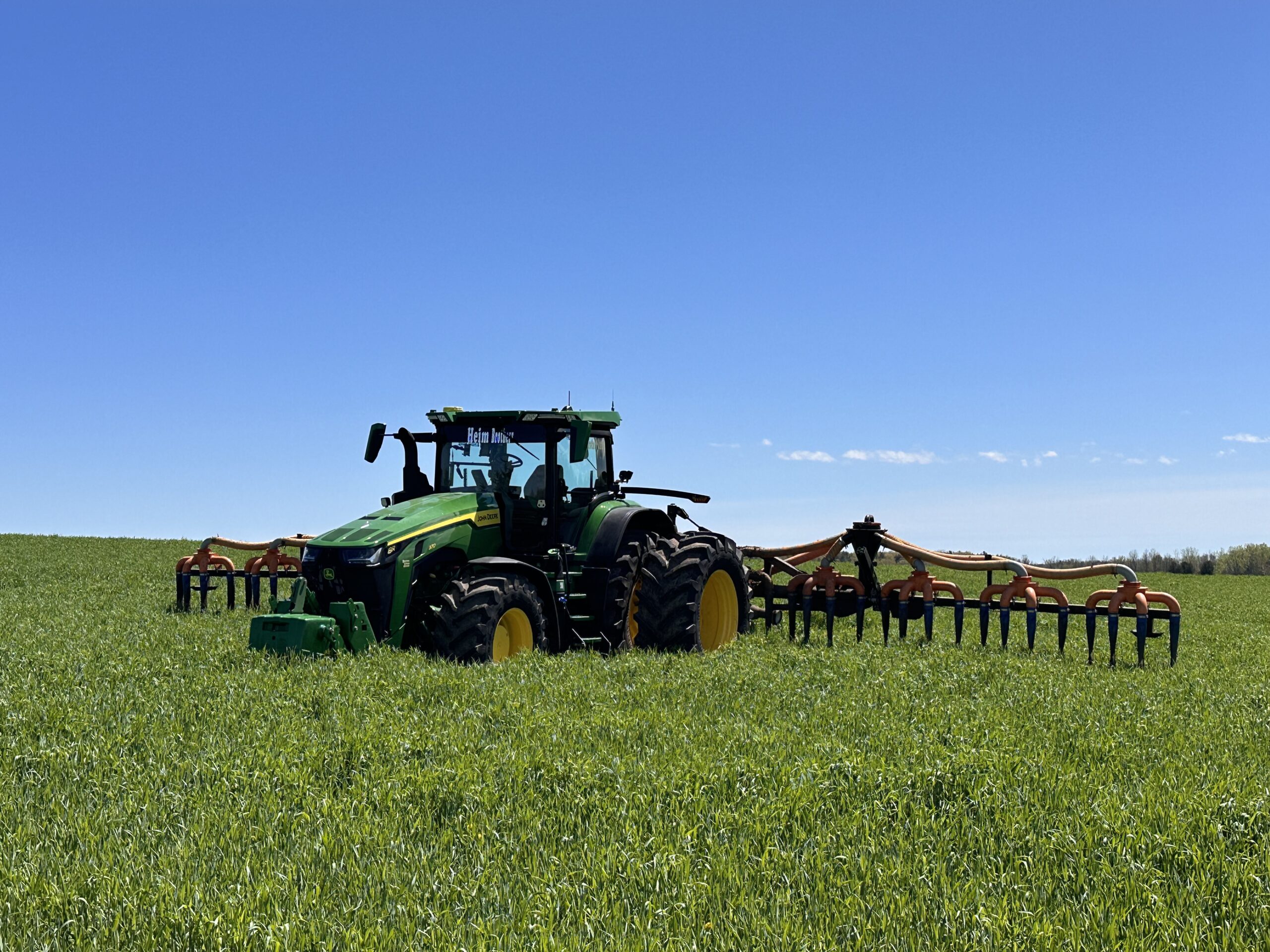Besides the obvious odor, the big stink surrounding manure lies in contamination of drinking water. According to a 2021 federal study, manure content in drinking water was found to be the major cause of gastrointestinal illnesses in Kewaunee County.
Cattle outnumber people 5-to-1 in Kewaunee County, which has more dairy cattle than any other county in the state and shares a border and karst geology with Door County.
One way farmers dispose of manure produced by dairy cattle is spreading it on agricultural fields as fertilizer, a common practice in Door and Kewaunee counties. However, this can lead to contaminants making their way into the groundwater that feeds private wells, as it did in Kewaunee County in 2019.
The League of Women Voters of Door County hosted a forum titled “The Big Stink: A Question of Manure” on April 23. The event, held at Crossroads at Big Creek in Sturgeon Bay, shared information that the League gathered in a study of manure management and groundwater contamination. (Disclosure: Knock partners with the League to co-host issue-based community forums. Knock was not involved in this forum.)
Representatives of the agricultural, regulatory and conservation communities were on hand as presenters.
The study and forum were prompted by Door County residents concerned about their drinking water after Kewaunee’s issues. Last year, Christine Reid of the group Friends of the Forestville Dam asked the League’s Natural Resource Committee to look into whether Door County should adopt the same manure spreading regulations as Kewaunee County.
Natural Resource Committee chair Virge Temme said the committee was already looking for a new project and this one fit the bill. Over the course of several months Temme and her committee did a deep dive into manure, to learn as much as they could about manure management and water quality in Door County.
Background
Manure management is heavily regulated, and the League started its research by doing a line-by-line comparison of Kewaunee County’s regulatory code and Door County’s, Temme said.
The codes are identical, except that Kewaunee prohibits liquid manure spreading between January 1 and April 15. That prohibition on those dates is arbitrary, but Friends of the Forestville Dam has been interested in adopting it for Door County, Temme said.

But Temme disagrees. Arbitrary calendar dates are no longer effective, she said, especially when the climate is changing. “Farmers and regulators are looking at the situation on a week-by-week basis with temperature and soil conditions,” she said.
Both counties prohibit liquid manure spreading on frozen or snow-covered ground.
“I understand their fear,” Temme said, referring to Friends of the Forestville Dam and other concerned residents. “This project is a worthwhile venture. I think a lot of myths were dispelled and eyes opened to how well things are regulated.”
Farmers
Forum presenters representing the farming community were Duane Ducat of Deer Run Dairy, and Jeremy Heim of Heim’s Hillcrest Dairy in Kewaunee County. Heim also has a nutrient application company called Heim Brothers Custom. Both farmers shared the ways their farms are managing manure with water quality in mind.
In recent years Deer Run Dairy, which has about 2,000 cows, switched to sustainable farming practices like planting cover crops, no-till methods, planned grazing, and using a manure digestor, which reduces pathogens and acts as a “pasteurizer” for manure, Ducat said.
Hillcrest Dairy also practices cover cropping, and Heim is a licensed nutrient applicator who hauls and spreads manure for other farms through Heim Brothers Custom. They hauled and spread almost 200 million gallons of manure last year, Heim said.
Heim Brothers Custom uses the latest technology to apply manure and follow nutrient management plans. These plans dictate how much manure and fertilizer can be used on fields, and, by law, every farm must have a nutrient management plan.
Heim said a “dribble bar” allows his company to get the most absorption of manure on a field, versus older methods of spraying, splattering or “painting” fields with manure.
Technology like digital field maps means spreaders like Heim Brothers Custom can track weather, rates of application, speed and different application methods depending on the individual land characteristics.
The technology does not come cheap, according to Heim, but it provides indisputable accountability.
“We’ve spent over half a million dollars in tracking equipment, but I think it’s the most valuable thing we ever invested in,” he said. “I encourage anybody that is challenging us to stop by a field and talk to me or my son, and we’ll show you what exactly is going on. I have nothing to hide, and that equipment allows me to share that and prove that to anybody.”
Regulators
Farms with 1,000 or more animal units are considered Concentrated Animal Feeding Operations, or CAFOs, and are regulated by the Wisconsin Department of Natural Resources. Because of size and waste output, 710 dairy cows are considered equal to 1,000 animal units. There are about 200 farms with animals in Door County, and only two of them are CAFOs, according to presenter James Salscheider, a DNR wastewater specialist for Door and Kewaunee counties.
The Door County Soil and Water Conservation Department is responsible for enforcement of standards for smaller farms, “whether it’s two pigs or 300 cows,” said Timothy Dahl, a conservationist for the department. The department reports to the Land Conservation Committee, which is made up of County Board members and a representative from the farming community.
Dahl and his coworkers are authorized under state law to enforce Chapter 23 of the Door County Code, which has three performance standards for manure management, he said.
Nutrient management plans are the key component of these standards, Dahl said, and they dictate how much manure and other fertilizer can be applied to farmland. Crop types, soil testing and field conditions determine amounts and size of setbacks from sensitive areas like wells, creeks or sinkholes.
The county department and the DNR inspect manure applications and whether the farm is following its own specific nutrient management plan, and both Dahl and Salscheider said their departments are very responsive to calls from the public about manure spreading.
“We’ll drive around, see somebody applying, stop right then, and we’ll talk to them,” Dahl said. “Anytime somebody calls with a concern about manure spreading, we send somebody there usually the same day.”
Environmentalists
Sara Fry is the private water reporting and enforcement coordinator for the Wisconsin DNR. She detailed Door County’s unique geology during her presentation.
In the 1970s, a high volume of coliform bacteria was found in some private wells in the county, Fry said. Coliform is an indicator a well is contaminated with disease-causing organisms like E. coli.
These testing results led to a Door County well code that requires special well casing depths when a new well is drilled, Fry explained. The deeper well depths are intended to seal off fractures in the upper portion of the limestone dolomite above the aquifer. Water flowing through those fractures has a higher chance of containing contaminants like manure, she said.
Door County well codes give the DNR authority to establish special well casing depth requirements in parts of the state identified as being at higher risk of contamination, according to Fry. This means a minimum casing depth of 100 feet for wells, and up to 170 feet depending on location and geologic features.
The levels of coliform, nitrates and other contaminant levels in Door County wells are promising, Fry concluded. She cited the county’s initiative to pay a private company to sample wells, which resulted in 89 wells tested last fall. The report from that testing—which will be continued for another few years—said little was found to raise concerns about drinking water quality.
Fry emphasized that residents should get their wells tested regularly, though it is not required by law, and contact the DNR if they have any suspicions about their drinking water. Changes in color, taste or other appearance are red flags of contamination, she said.
The final presenter at the forum, Dean Hoegger, represented environmental lobbyists focused on preventing water contamination. Hoegger is the executive director and president of Clean Water Action Council.
Hoegger said he thinks one way to protect water quality is to question the quality of manure itself.
Whether liquid manure is a fertilizer or waste product depends on how it is managed, stored and spread on the ground, he said.
Liquid manure is a very thin fertilizer when untreated, according to Hoegger, which means you need more liquid manure to get the same result as fertilizer. Treated manure, whether composted or using other methods, has a higher concentration of nutrients and is a more viable fertilizer, he said.
Methods of storing waste in manure pits are not practical or sustainable, he said. The number one risk factor for well contamination is proximity to a manure pit, according to Hoegger, because of leakage.
As far as the relationship between environmental activists and regulatory agencies, “you need to be ready to shake hands and work with them,” he said. Since 2020, the trend in nitrate contamination is going down, he added, a good sign that combined efforts are making a difference.
Hoegger and his team work to improve environmental legislation in other ways. Submitting briefs for lawsuits; appealing to local governments to deny, revoke or rescind permits when appropriate; and lobbying soil and water departments, county boards and zoning committees to extend setbacks are all things one can do from a practical and legislative standpoint, he said.
Spreading education, information going forward
The League is releasing a report of its research and study of manure management in May or June, according to Temme. Time did not allow for audience participation in the forum, but input was collected and questions and comments will be responded to in the report as well, she said.
Temme acknowledged that while the League’s findings indicate manure management is moving in the right direction, not every farmer is on the same page. Forum presenters Heim and Ducat represent those that are using cover cropping, no till methods and other sustainable practices, as well as cutting edge technology to track and manage their manure spreading operations.
But there are plenty of farms that are still doing things “the way they’ve been doing them since the 1950s,” Temme said. Some of that may be fear of making a big transition, she said, and also not a lot of financial incentive.
“I know the state legislature doesn’t want to spend more money on the farm bill, but somehow or another we need to get our legislators on board to improve soils and improve the productivity of soil,” Temme said. “We’ve got to get rid of old world thinking.”

